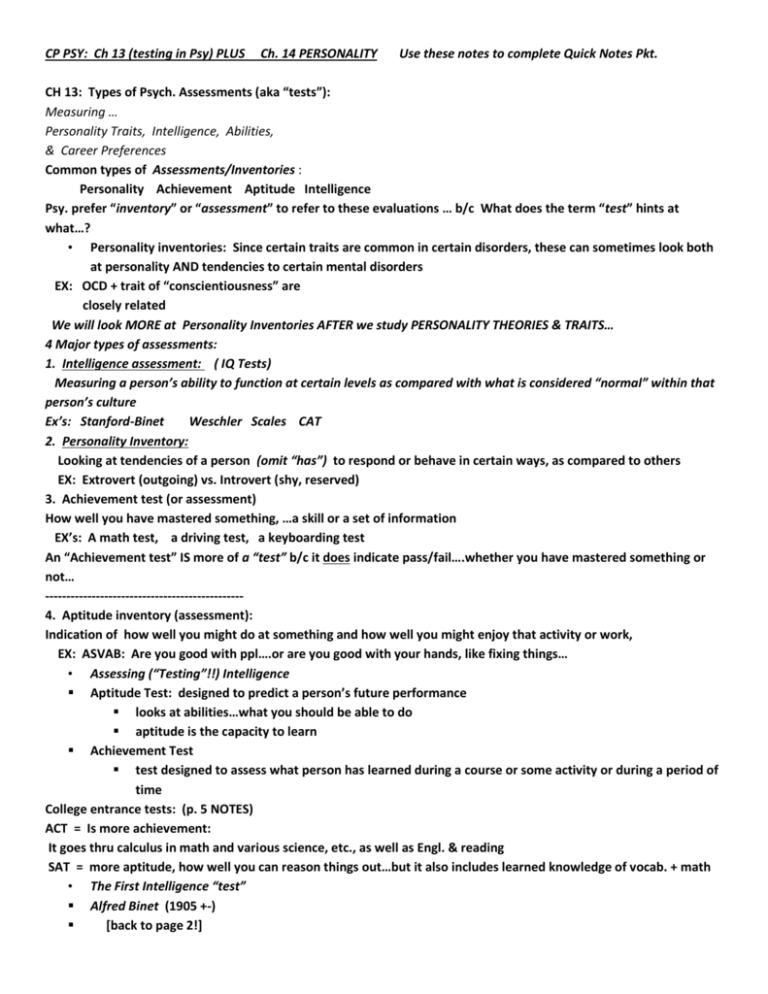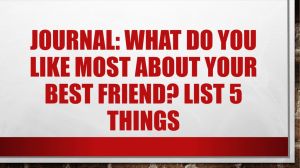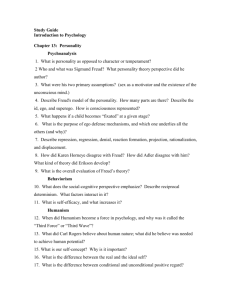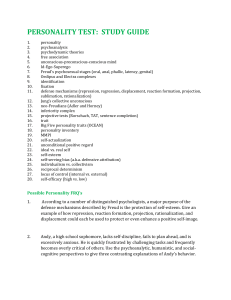CP PSY: Ch 13 (testing in Psy) PLUS Ch. 14 PERSONALITY Use
advertisement

CP PSY: Ch 13 (testing in Psy) PLUS Ch. 14 PERSONALITY Use these notes to complete Quick Notes Pkt. CH 13: Types of Psych. Assessments (aka “tests”): Measuring … Personality Traits, Intelligence, Abilities, & Career Preferences Common types of Assessments/Inventories : Personality Achievement Aptitude Intelligence Psy. prefer “inventory” or “assessment” to refer to these evaluations … b/c What does the term “test” hints at what…? • Personality inventories: Since certain traits are common in certain disorders, these can sometimes look both at personality AND tendencies to certain mental disorders EX: OCD + trait of “conscientiousness” are closely related We will look MORE at Personality Inventories AFTER we study PERSONALITY THEORIES & TRAITS… 4 Major types of assessments: 1. Intelligence assessment: ( IQ Tests) Measuring a person’s ability to function at certain levels as compared with what is considered “normal” within that person’s culture Ex’s: Stanford-Binet Weschler Scales CAT 2. Personality Inventory: Looking at tendencies of a person (omit “has”) to respond or behave in certain ways, as compared to others EX: Extrovert (outgoing) vs. Introvert (shy, reserved) 3. Achievement test (or assessment) How well you have mastered something, …a skill or a set of information EX’s: A math test, a driving test, a keyboarding test An “Achievement test” IS more of a “test” b/c it does indicate pass/fail….whether you have mastered something or not… ----------------------------------------------4. Aptitude inventory (assessment): Indication of how well you might do at something and how well you might enjoy that activity or work, EX: ASVAB: Are you good with ppl….or are you good with your hands, like fixing things… • Assessing (“Testing”!!) Intelligence Aptitude Test: designed to predict a person’s future performance looks at abilities…what you should be able to do aptitude is the capacity to learn Achievement Test test designed to assess what person has learned during a course or some activity or during a period of time College entrance tests: (p. 5 NOTES) ACT = Is more achievement: It goes thru calculus in math and various science, etc., as well as Engl. & reading SAT = more aptitude, how well you can reason things out…but it also includes learned knowledge of vocab. + math • The First Intelligence “test” Alfred Binet (1905 +-) [back to page 2!] Developed the first standardized way to assess an person’s mental aptitudes & compare them to other ppl’s , using numerical scores He tested Paris school kids to ID those who were low & needed help Lewis Terman: Later Binet’s test was altered by Terman & others at Stanford University (California) and it is now known as the StanfordBinet Intelligence Quotient Assessment Stanford-Binet IQ Assessment was just “verbal” (MATH is considered in “verbal”—because you have to SPEAK or WRITE a correct answer) • Wechsler Adult Intelligence Scale (WAIS) Most widely used intelligence test (developed for WWII) 2 subtests 1) verbal 2) performance (nonverbal) WAIS-R = revised adult test; WISC-R = revised kids’ test NORMS: What is generally considered “normal” … [Write in this NEXT section ] …or about what 50% + of kids at an specific age is capable of • What is meant by IQ? Mental Age measure of intelligence test performance devised by Alfred Binet, Paris, late 1800’s Why? to ID slower kids in Paris school system to help them do better chronological age: actual age mental age: if a child does as well as the average 8-year-old is said to have a [add] MENTAL AGE of 8 Stanford-Binet Intelligence Assessment: A widely used American revision of Binet’s original intelligence test (1914-15 ) The Stanford-Binet added the intelligence quotient (IQ) Intelligence Quotient (IQ) Originally, ratio of mental age (ma) to chronological age (ca) multiplied by 100 IQ = ma ÷ ca x 100 (ma/ca x 100) On contemporary tests, the avg performance for a specific age is assigned a score of 100 Most intelligence tests (including the Stanford-Binet) no longer compute an “IQ” score because it attempts to give a “concrete value” to an “abstract concept” (This is called reification) EX: Height is a CONCRETE value…is a specific measure….IQ is not See next slide.. What IS Intelligence? The ability to learn from experience, solve problems, & use knowledge to adapt to new situations Intelligence is determined by a social definition & varies from culture to culture, era to era WAIS-R: Wechsler Adult Intelligence Scale-Revised WISC-R: Wechsler Intelligence Scale for Children-Revised • Assessing Intelligence: American David Weschler added Performance Component in 1939 b/c of problems assessing those w/ some verbal disadvantages (like native German or Russian speakers) Sample Items from the WAIS WAIS-R EX’s: Visual Analogies…..block design….. pic sequencing…..WAIS-R performance assessment kit • The Brilliant Calvin…& his Feline Friend Hobbs Genetic Influences: Psychologists look at both twin studies TWINS: BOTH identical + Fraternal AND reared together or apart Plus they look at adopted kids…to see if adopted kids are [ignore extra blank!] more like their biological parents OR their adoptive parents Intelligence has a very high “heritability rate” Intelligence heritability is about 50% The most genetically similar people have the most similar scores • Group differences & impact of environment: The Seed Analogy: USE Same seeds (same DNA…genetics) (notes p. 4!) BUT-- different soil & levels of fertilizer & water & sun These = a different ENVIRONMENT..Would they grow JUST AS WELL? HUMAN Analogy: HEAD START: Data from research on Head Start programs (public “pre-school” to helped kids from Lo-socio-econ. environments) show H - S kids are less likely to repeat grades than those in similar environments NOT in Head Start Aptitude “tests” vs. Achievement “tests”: • Aptitude inventory measures how you might do well in a certain area, like business or research…how you might enjoy it EX: ASVAB …What might you be good at & enjoy? • Achievement test or assessment: how well you have mastered something, like a math test = achievement EX: Driving test, keyboarding test ACT = Is more achiev.: it goes thru calculus in math and various science, etc., as well as Engl. & reading SAT = more aptitude, how well you can reason things out…but it also includes learned knowledge of vocab. + math Ch. 14: (See p. 5 of Notes)*Personality: the consistent, enduring (long-lasting), & unique characteristics of behavior in people What’s the purpose of “personality theories”? a) Organize & understand characteristics of ppl b) Explain how & why folks are different c) Look at how personality affects our lives & behaviors d) Look at how we can improve life in spite of the tendencies of personality • The 5 Major personality Theories: 1) Psychoanalytic (Freud); now = “psychodynamic” or “psychosocial” 2) Humanistic (Rogers + Maslow) 3) Behavioral (aka “Learning”: Skinner & Bandura) 4) Trait (Allport) 5) Humanistic-Cognitive (Rogers, Maslow, May, & Beck) 1) Psychoanalytical theory (psychoanalysis): Sigmund Freud’s ideas Austrian doctor; wrote/worked 1890’s – 1930’s… -his influence lasted into 1960’s -Many of his ideas are no longer accepted by most psychologists b/c they didn’t “test out” …were not “valid” scientifically But did have great influence on psychology & our culture 1) he began clinical psych (psychotherapy: talk therapy) 2) BEST & BIGGEST contribution: acceptance of the unconscious & subconscious (hidden parts of the human mind) Freud’s idea of the mind’s structure: His Iceberg analogy (p. 379) Conscious: what we’re aware of Preconscious (aka subconscious): just at or below the surface Unconscious: below the surface…what we hide from ourselves Freud’s 3 personality parts: Id, ego, & super-ego 1) id: These are our basic drives, our wants & desires; “I want what I want when I want it…” not really “evil”, just selfish, self-centered 2) superego: tells you to follow society’s rules & moral teachings; “Listen to your mother!!” It’s your “conscience.” Makes you feel guilty 3) ego: has to negotiate between these 2 & make decisions about how to behave… Freud said conflicts between 3 personality parts cause mental disorders & stresses We use “defense mechanisms” to “hide” these conflicts from ourselves, in our preconscious & unconscious Freud said these keep the disorders going, & we have to face them to “clear the air & cleanse our minds” -therapist job is to guide you to this …& therapist is in charge of the process 8 Common Defense Mechanisms (from Freud) 1. Rationalization: when we make up acceptable excuses for our behaviors that might upset us if we admit it. EX: 2. Repression: blocking a threatening idea, memory, or emotion from consciousness EX: 3. Projection: Attributing our own unacceptable feelings & impulses to someone else… EX:? 4. Displacement: Directing your emotions, especially anger, toward things, animals, or others that you’re not really angry at instead of what really made you upset EX: ? 5. Sublimation: special displacement where your emotions are used in acceptable ways, like art or literature to “get out your anger”, etc. 6. Reaction formation: changing upsetting thoughts or feelings into their opposites 7. Regression: moving backwards to earlier “baby-ish” or childish behaviors 8. Denial: refusing to admit something unpleasant is happening or that a forbidden emotion is being felt; -denial blocks or distorts perceptions -repression blocks or distorts memory… Freud’s Ways to access (get to) the unconscious & subconscious: 1) free association: Opening mind by “tricking” it or just letting it “flow”… “I say a word--& you tell me what 1st pops into your mind” “Just lie there & say 1st thing you think of….” Freudian slip: When you’re talking & unconscious thought slips out that you would like hide: “This is the breast…I mean best..party…” (GO TO p.9 of notes!) 2) dream analysis/symbolism in dreams; psychoanalyst “interprets & explains dreams to help you face & get rid of what’s bothering you 3) info you give to the analyst RE: your childhood, thoughts, etc.; she interprets & “figures you out” 4) hypnosis: opened paths to preconscious & un- conscious Psychosexual Development: (Did this b4!!) Freud: said all human personality development is tied to childhood sexual stages & childhood events Stages: controlled by certain “erogenous zones” at different childhood ages Freud: we work out or “solve” a certain task at each stages in order to move on to the next stage If we DON’T go thru it right, we get “stuck” (“fixated”) in a stage & have problems from that …like mental disorders, extreme stress, anger….. ….& avoid facing by using defense mechanisms 1) oral stage: birth--about 18 months; main task = weaning…& if we don’t do properly, can be sarcastic (“biting”) or obsessed w/ things in their mouth EX’s: chewing fingernails or pencils, smoking, over-eating, etc. 2) anal stage: about 1 ½ yrs. – 3 yrs.: main task = toilet training -conflict/problems w/ this can cause either…. anal retentiveness (extremely neat, orderly, concerned with details)…… Now called OCD! -or anal expulsiveness (extremely messy, disorderly) 3) phallic stage: about 3 yrs. – 6 yrs.: task = identify sexually w/ same sex parent PROBLEMS if phallic stage isn’t work thru properly: --Oedipus complex: boys love Mom & want to replace/kill father --Electra complex: girls love Daddy & want to replace/kill mother -- girls can develop “penis envy” at this stage b/c see themselves as missing “something” --homosexuality develops if boys identify w/ mom instead of dad (…or girls w/ dad) BUT… There is NO evidence for any of this…. Freud saw homosexuality as a disorder BUT…. It is no longer viewed as disorder by psychologists 4) latent stage: 6 yrs. – 11 yrs.; no real task to work out -experience gender segregation: separate themselves by gender…boys hang out only w/ boys, girls w/ girls 5) genital stage: 11 yrs. thru adolescence: Identify romantic feeling for opposite sex; develop into “normal” relationships -libido: to Freud, the drive & the energy that pushes & motivates us to do and/or get things; --now mainly refers to our “sex drives” WHY we still study Freud: 1.Subconscious & Unconscious At 1st Psychologists said we should not study these b/c these were NOT observable behaviors 2. His “talk therapy” or “psychoanalysis” was the FIRST psychotherapy… ….Psychology was MAINLY “behaviorism“ b4 that 3. Many of our cultural ideas that come from Freud: Defense Mechanisms, anal retentive, etc. Other Freudians: Carl Jung: Worked w/ Freud had disagreement w/ Fr. & Fr. threw him out…his 3 major ideas: 1. The collective unconscious: idea that we all have access to memories and knowledge in a “pool of information” just b/c we are humans 2. Archetypes: these come from “pool of knowledge Same ideas about certain types of ppl are in each culture: EX’s The Hero….the Damsel in distress, The Villain….etc. 3. Main idea (STILL in Psych today!) Terms introverts (shy) & extraverts (out-going) Alfred Adler: developed “inferiority” & “superiority” complexes: we try to be what we can’t & so we feel badly about ourselves… & often act aggressively (bullies) Birth order” theory: Adler said it determined part of your personality…but has NOT been shown to be true More Freudians… There are few—if any—true “Freudians today…. Those based on Freud’s ideas now call themselves “psychosocial” or psychodynamic psychologists…not psychosexual… & they don’t believe sex is our main motivation These now say the urge to socialize with others is the main drive in humans… …1st w/ family, then w/ friends, then lovers, etc Karen Horney: psycho-dynamic or psycho-social: rejected Freud’s psycho-sexual theories & said it was a need to belong, to socialize She also rejected “penis envy” & said it was the power, not the sexual organ, that women envied • Other Freudians: Carl Jung Karen Horney Alfred Adler 2) Behavioral (aka “Learning”) Personality Theory: RE: behaviors Rewards & punishments thru life make us the way we are… we learn to respond a certain way. B.F. Skinner: said personality is shaped by how we learn thru rewards & punishments…& these consequences shape our behavior A.Bandura: said we learn to behave & respond certain ways by watching & learning from others (social learning theory) & by thinking about previous information we learn (cognitive learning) Walter Mischel: said personality is not really enduring, so there really is no such thing as “personality”….it is ALL just situational, meaning it all depends on each situation. 3) Humanistic + cognitive: C. Rogers & A. Maslow Carl Rogers (Humanistic psy): Rogers’ ideas: His Ideas: We all have great potential & our personality is based on our ideas about ourselves…. how we see ourselves as “good…bad…stupid, smart”etc. If we change how we think about ourselves, we change our outlook & happiness Parents should show kids unconditional positive regard….which is “I still care about you even if I am not crazy about your behaviors, because I know you are good.” How we think & feel about ourselves affects our personality & behaviors • Humanist Personality Theorists: Carl Rogers Abraham Maslow Unconditional positive Hierarchy of needs regard… I like YOU! & self-actualization Abraham Maslow: Developed self-actualization theory which said we all want to “be the best we can be” Maslow also developed the hierarchy of needs: We have to meet basic needs 1st, then move higher & higher up: 1st = physical.. then safety …then belongingness …then self-esteem … Then …self-actualization, the highest level.& reached by few. (GO TO Notes p. 10 & complete using next slide, OR p. 327 in book)) • Other personality theorists: B.F.Skinner we learn thru Rewards/punishments Albert Bandura We learn by watching others Walter Mischel It’s ALL the situation …there are no true “personality traits” 4) Traits Theories & Genetics: Esysenck & Allport Inborn (is it heredity?) Esysenk looked at genetics in personality traits & said traits are heritable (can be inherited) Some, especially the 6 later slide), do tend to show this Note: A common theory is “the Big Five” but many add a 6th Studies w/ identical twins raised apart do support this “genetic PERSONALITY traits” idea • 4) Traits Theories & Genetics (continues…) Do our traits change a LOT as we age or do they stay somewhat the same? (stability vs. change) Gordon Allport: 1st to lay out idea of trait theory & said traits are “stable”: that is, they tend to stay the same, though they can vary with situations & with experience. Introverts & Extroverts HOW MANY TRAITS?? There are various theories about how many actual stable (?) traits there are… Is it 5, 6, 10, 16, even 24…? A common theory is “BIG FIVE”… ….but many add 1 more.. & these are … 1) Introversion or Extraversion: Shy…or outgoing? Which would this be? 2. Openness to experience (aka “risk-taking”): Do you take chances & try new stuff…..or are you cautious & resist change & trying new things? (New ppl? New foods? Travel? NOT just danger! 3) Agreeableness: Hi or Lo?? How well we get along w/ others: Do we tend to be friendly & work well with others? OR somewhat ornery, hard to get along with? 4) Conscientiousness: Responsible & take care of details, etc. .. Hi or lo?? …or somewhat slack… • 5) Emotional stability (aka neuroticism): Confident, relaxed, & not easily upset… OR get upset easily, & freak out a lot…? • 6) Traditional: **(this is the “extra” one) Follow rules most of time… …OR rebellious? • Types of Psych. Tests/Assessments: Inventories, Assessments, test: To measure Personality, Achievement, Aptitude • What does the term “test” hint at? • Psy. prefer “inventory” or “assessment” to refer to these evaluations • Personality inventories: Since certain traits are common in certain disorders, these can sometimes look both at personality AND tendencies to certain disorders EX: OCD + trait of “conscientiousness” are closely related Personality Inventories (use terms inventory OR assessment…not “test”): Can use to help diagnose mental disorders—OR help assess how well a person would do at a job The 3 BIG Persn. Inventories are MMPI-2, 16 PF, & NEO plus M-B MMPI-2: very long…567 ?’s; helps w/ diagnosing mental disorders like paranoia, depression, etc.; can be very good at this but is very expensive 16 PF looks at 16 traits NEO looks at the Big 5 (the list I gave you minus the “traditional” ) Myers-Briggs: most commonly used for simple personality inventory • Projective Personality Tests (see p. 15, NOTES) Projective tests allow you to “project” your own feelings & thoughts from your unconscious into some visual stimuli ….2 MAIN projective tests: Rorschach Test: aka “inkblot tests” When you see these you will think about things already in your unconscious T.A.T. (Thematic Apperception Test): You look at a picture & tell what YOU THINK is the story of what happened just before the pic, during the pic, & after the pic is taken… … so in the PAST, the PRESENT, and the FUTURE






